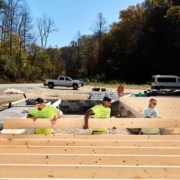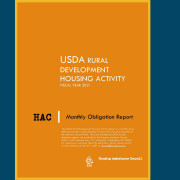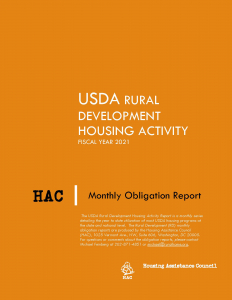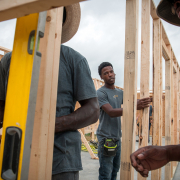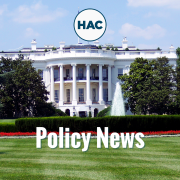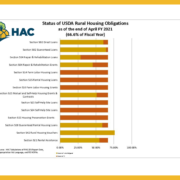The Housing Assistance Council (HAC) presents this month’s report on Fiscal Year 2021 USDA Rural Housing program obligations.
As of the end of July, USDA obligated 117,200 loans, loan guarantees, and grants totaling about $20.2 billion. This is nearly $3.9 billion more than obligation levels from this time last year. At that time, there were 103,122 loans, loan guarantees, and grants obligated totaling nearly $16.4 billion.
Federal agencies operated under a series of short-term continuing resolutions (CR) for most of the first quarter of FY 2021. A final CR was signed into law on December 27, 2020 which provides funding for the remainder of the fiscal year. Since March 20, 2020, USDA offices have been operating from remote locations due to the COVID-19 virus.
Single Family Housing Program Highlights
The Section 502 Guaranteed loan program, the largest of the Single Family Housing programs, obligated approximately $19.2 billion (108,193 loan guarantees) up from last year’s $15.3 billion ( 93,226 loan guarantees) this time.
For the Section 502 Direct program, loan obligations totaled $826.7 million (4,409 loans), a bit higher than last year’s obligation level of $742.2 million (4,310 loans.)
About 36 percent of the loan dollars went to Very Low-income (VLI) applicants. VLI loans represented over 42 percent of the total number of Section 502 Direct loans.
The Section 504 Repair and Rehabilitation programs obligated 1,700 loans representing almost $10.6 million. Loan volume was up from this time last year (1,912 loans representing about $11.6 million.) There were also about $18.3 million (2,784 grants) obligated in the Section 504 grant program compared to approximately $22.4 million (3,474 grants) last year.
USDA’s Section 523 Self Help Housing Grant program funded 30 grants and contracts totaling nearly $20.4 million compared to last year’s 19 grants and contracts totaling over $22.6 million.
Multi-Family Housing Program Highlights
USDA’s Section 538 Multifamily Housing program obligated 58 loan guarantees totaling almost $149.0 million compared to last year’s 96 loan guarantees ($156.7 million.) No Section 515 Rural Rental Housing program have been funded so far this year, similar to last year at this time. No loans or 5 grants have been obligated so far this year in the MPR program totaling $0 and $251,778 this year compared to 28 loans and 3 grants representing nearly $30.0 million and $988,734, respectively last year.
No Farm Labor Housing loans or grants have been funded so far this year. Last year at this time, 14 loans and 5 grants were obligated (about $19.8 million 794,577 and nearly $5.9 million, respectively.)
USDA obligated funds for 195,414 rental assistance units under the Section 521 Rental Assistance program totaling over $1.1 billion. This compares to about 178,225 units (over $1.0 billion) obligated same time last year. There were also 6,228 Rural Housing Vouchers totaling about $30.0 million compared to 5,700 vouchers representing over $26.4 million this time last year.
Download the combined document.
* The Rural Housing Service (RHS) monthly obligation reports are produced by the Housing Assistance Council (HAC) 1025 Vermont Ave., NW, Suite 606, Washington, DC 20005. The monthly figures derive from HAC tabulations of USDA –RHS 205c, d, and f report data. For questions or comments about the obligation reports, please contact Michael Feinberg at 202-842-8600 or michael@ruralhome.org.

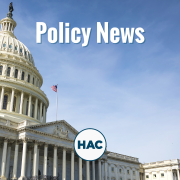
 Housing Assistance Council
Housing Assistance Council